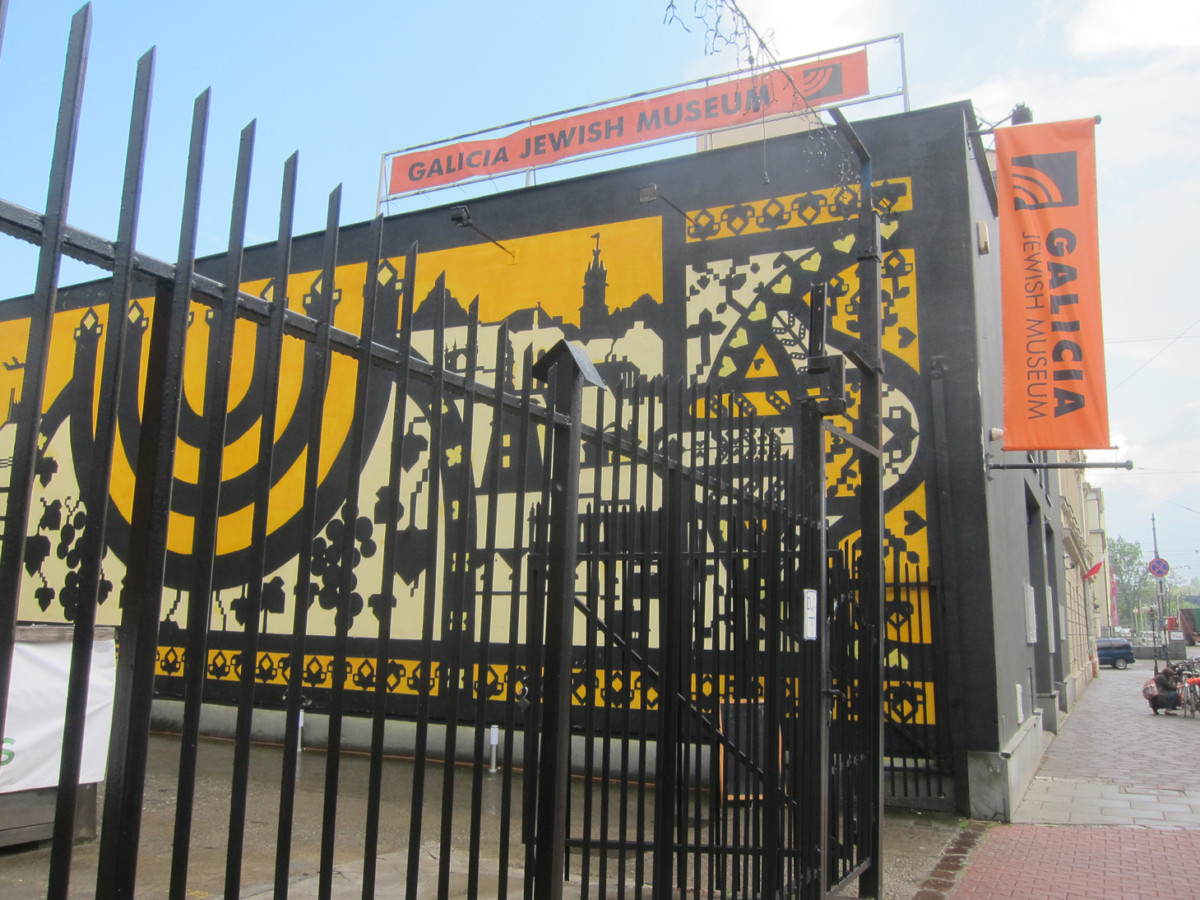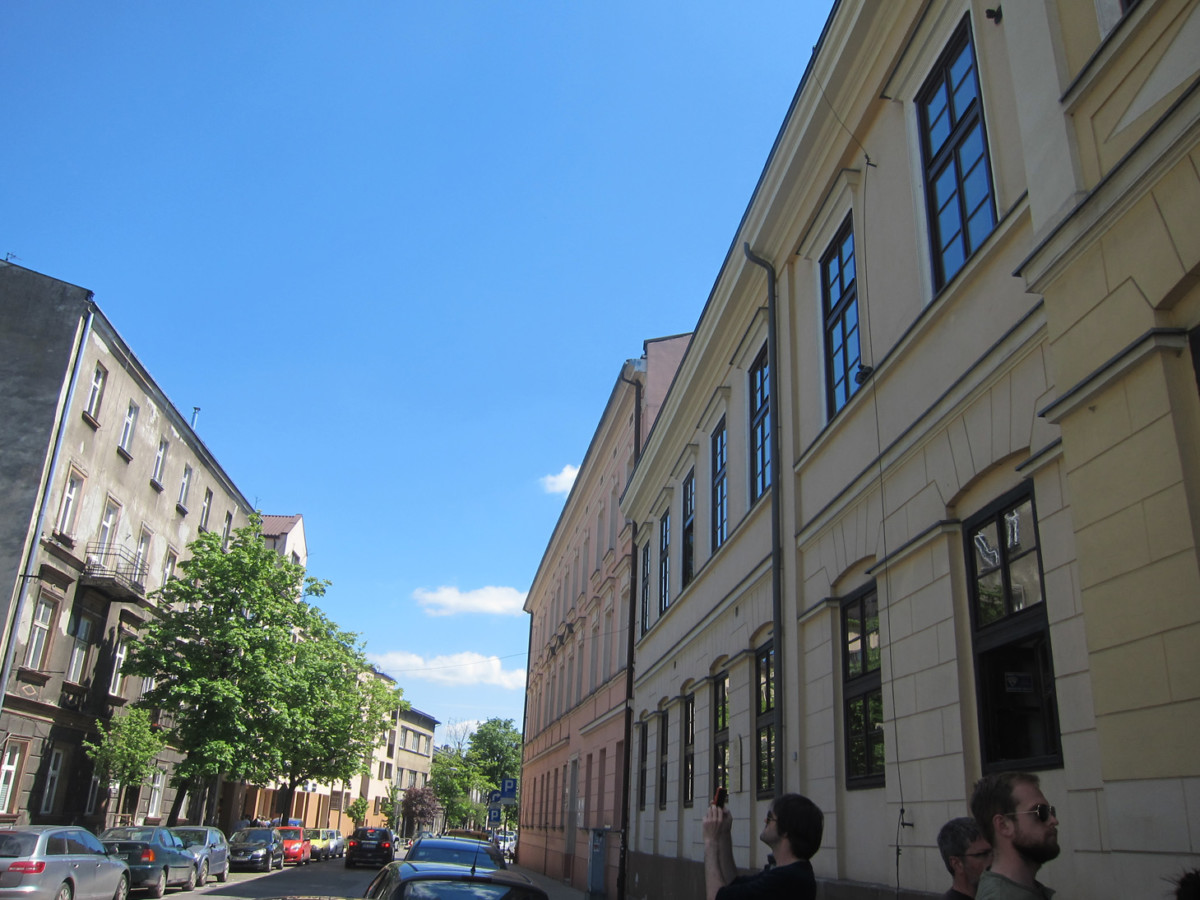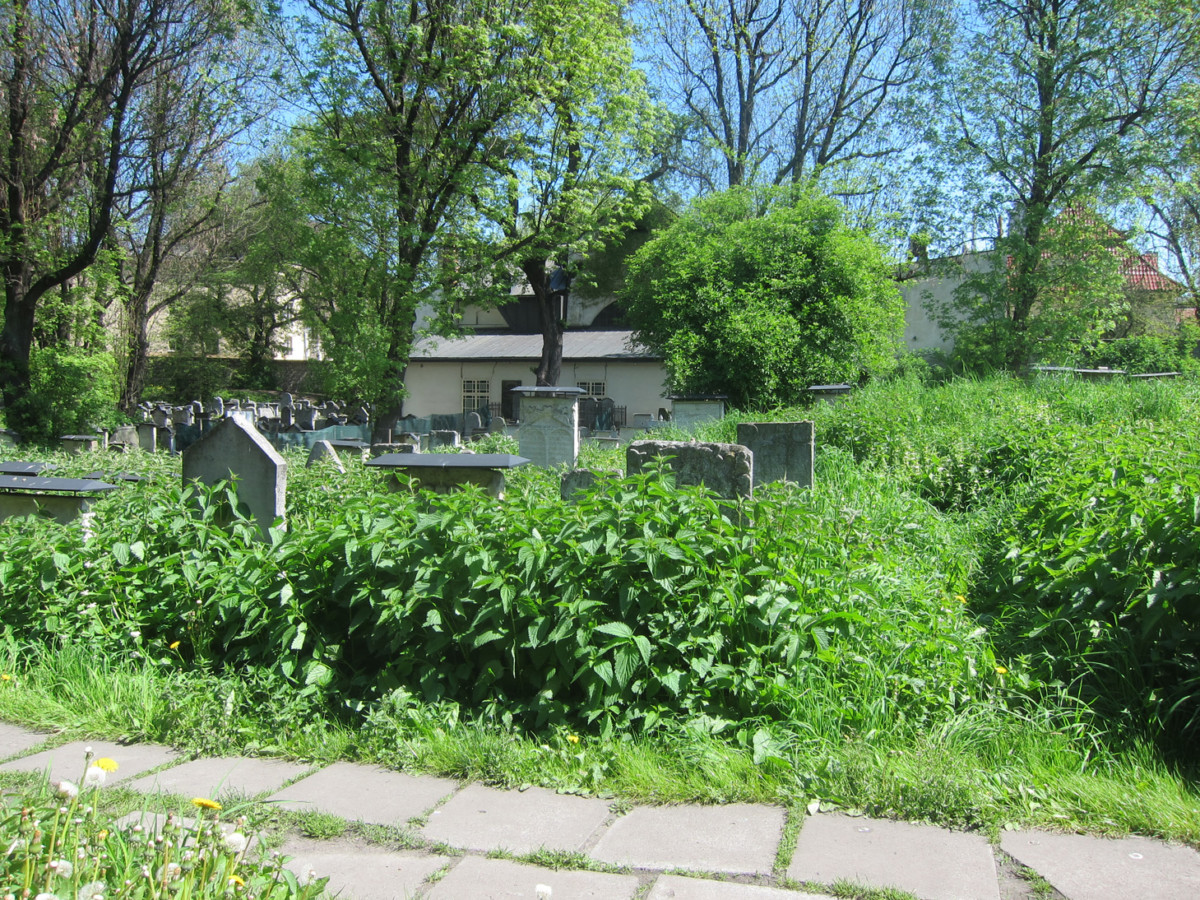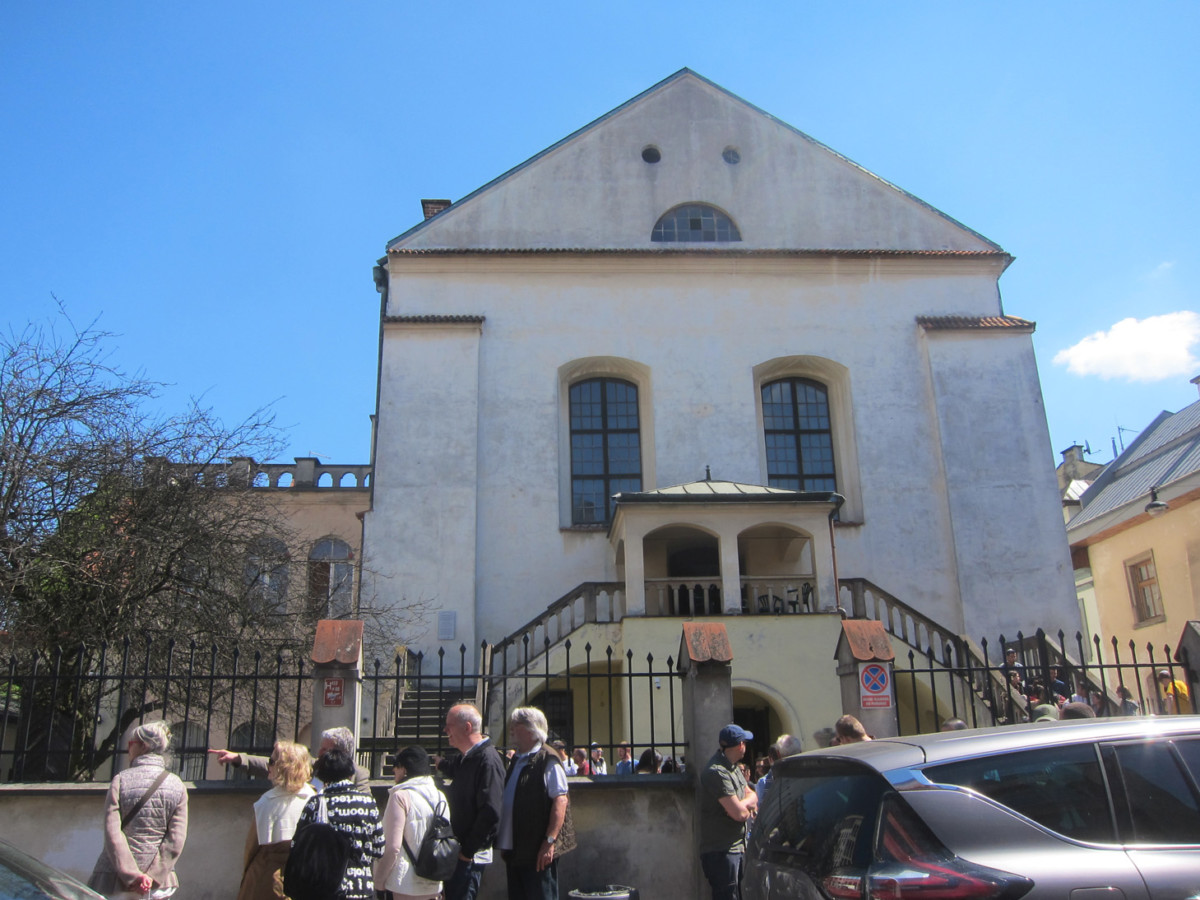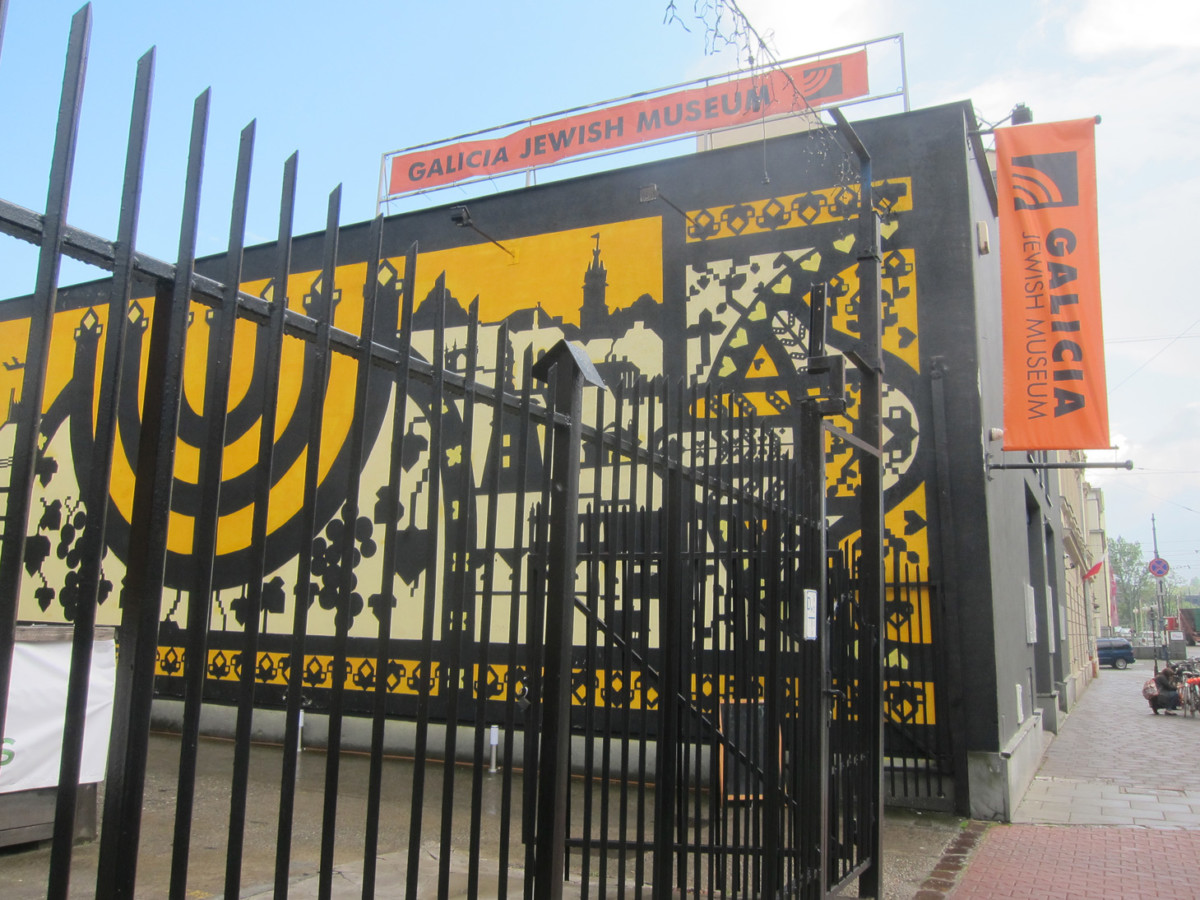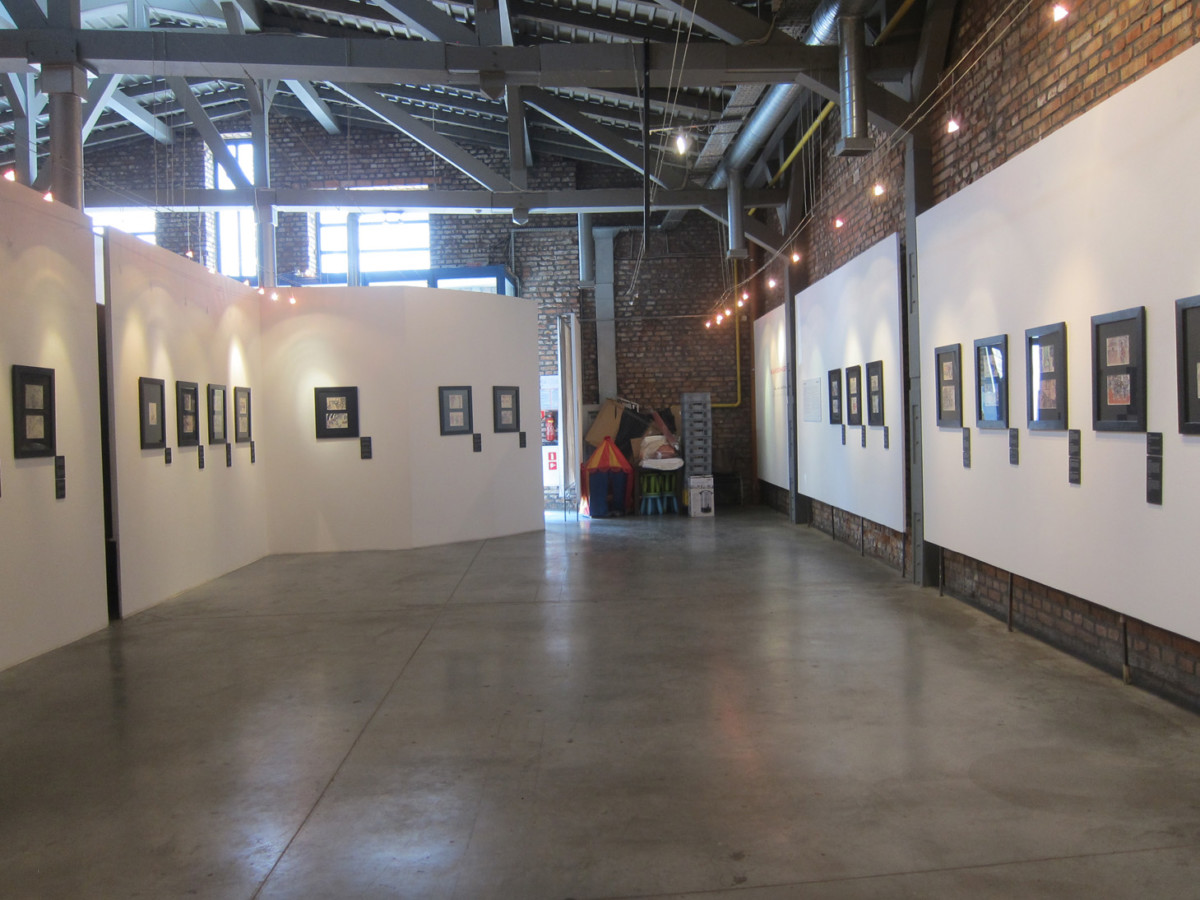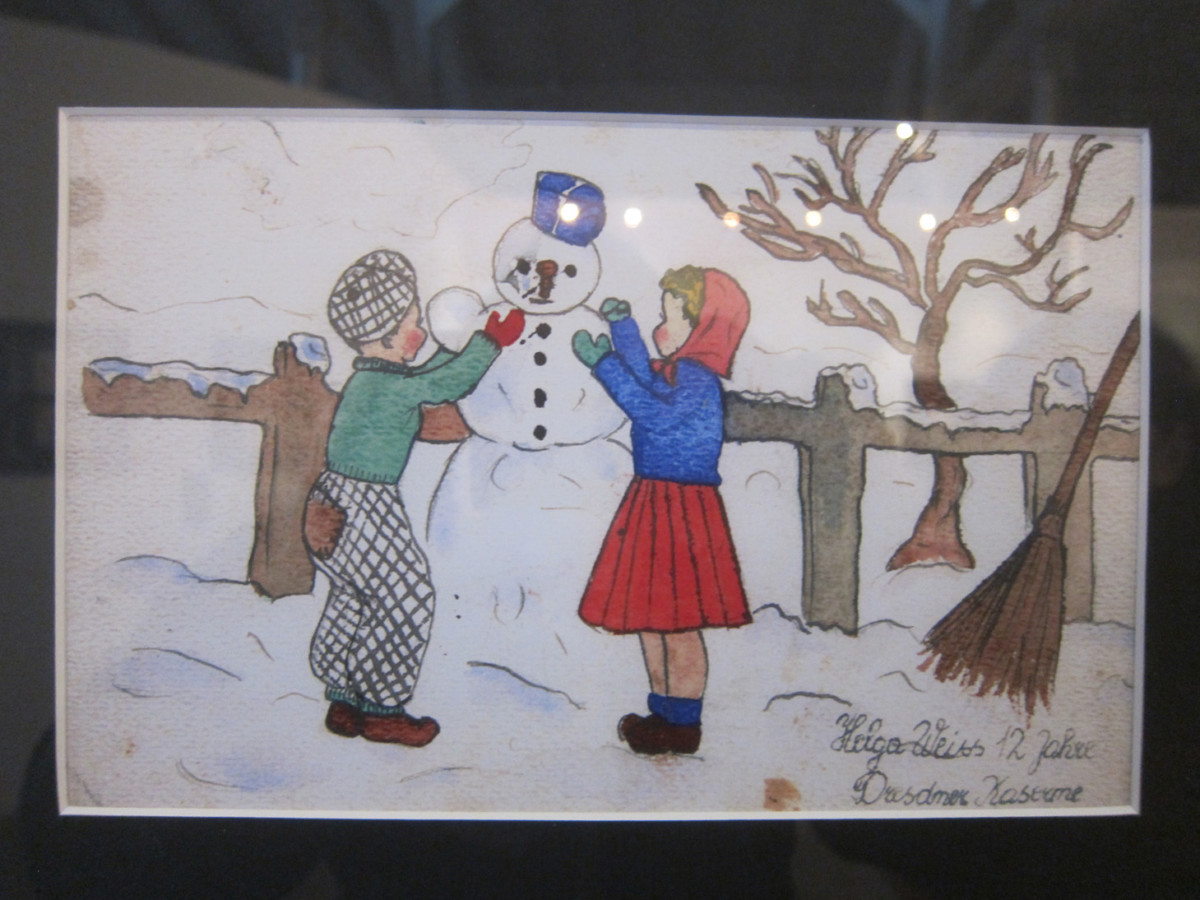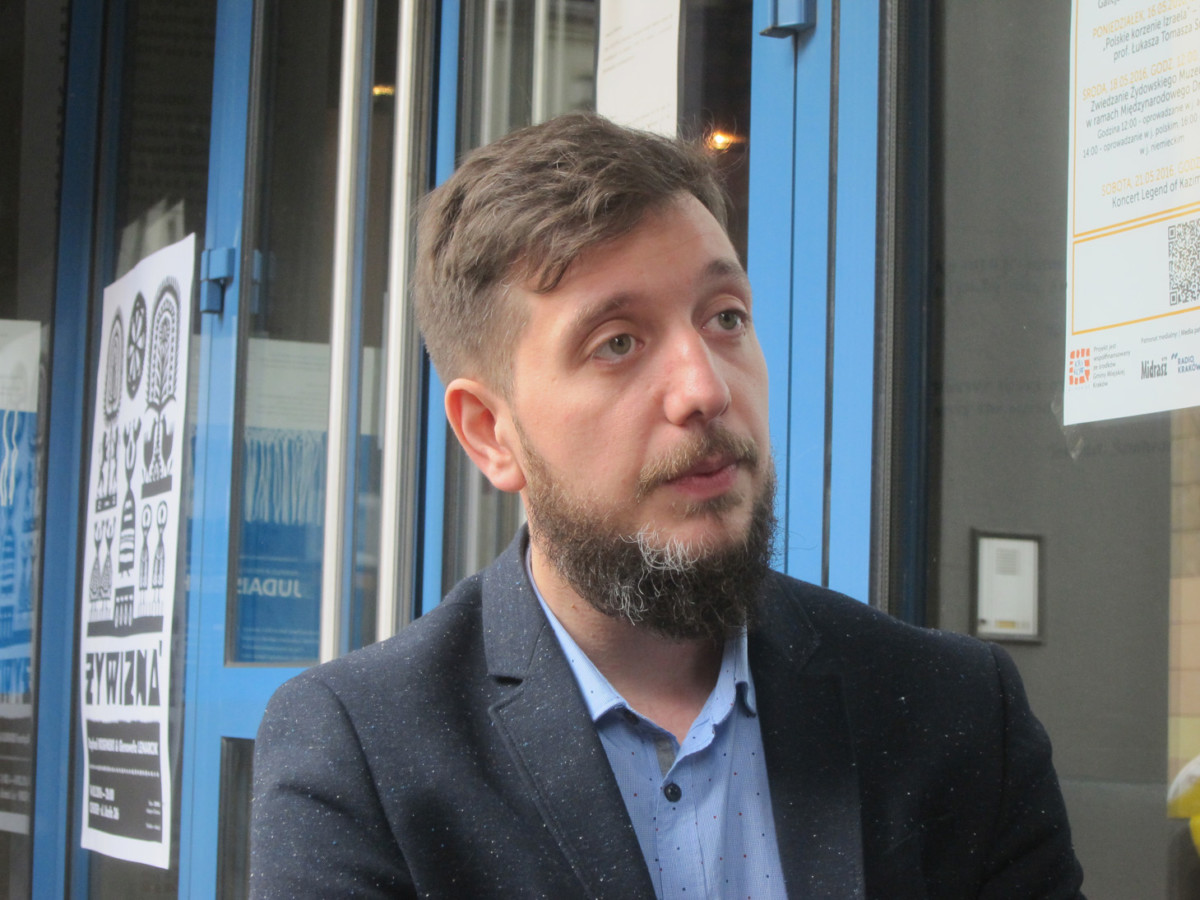"Paint What You See," temporary exhibit by Helga Hoskova-Weissova, Galicia Jewish Museum
It was standing-room only and people were being turned away on Friday, May 6, at the evening services of the Tempel Synagogue, across the courtyard from the Jewish Community Centre (JCC) on Miodowa Street in Kazimierz, Krakow’s Jewish Quarter.
The JCC was expecting a big crowd. Long tables were set for over a hundred people. Volunteers at the front desk handed out brochures in several languages and checked our names off a three-page list. JCC Executive Director Jonathan Ornstein was at the front door greeting the guests. “You’ve come to the right place,” he said, adding that the JCC now had over six hundred Jewish members, “depending on who you consider a Jew.” Within seconds, he moved on to shake the next hand but not before he handed me a business card.
We found two seats for the Shabbat dinner. The room was filled with groups of tourists, folks who clearly knew one another, from Los Angeles, from Las Vegas, from New York, from Canada, and from Israel—many of whom, we learned from the opening remarks at the dinner, had spent the day touring the Auschwitz-Birkenau Camp, a little over an hour’s drive from Krakow. Many had participated in the March of the Living in Poland the previous day, an annual event, taking place on Yom Hashoah—Holocaust Remembrance Day—when participants walk the three kilometers from Auschwitz to Birkenau in a silent tribute to the victims.
Over the past fifteen years, the camp has become a tourist hot spot, with the number of annual visitors rising to exceed the number of victims.
By tour buses, by trains, by private cars, visitors traveled to Auschwitz (formerly Oswiecim), established in 1940 but active as a death camp from 1942 until January of 1945. During the years of its existence, it is estimated that as many as 1.1 million victims died there. Over the past fifteen years, the camp has become a tourist hot spot, with the number of annual visitors rising to exceed the number of victims. A record 1.72 million toured the Auschwitz-Birkenau Memorial and Museum in 2015, a dramatic rise from the fewer than the 500,000 who traveled there in 2000.
An Israeli contingent, seated in the front two tables, was busily engaged in conversation. They hushed as Jonathan Ornstein began his remarks, welcoming the crowd to what, he said, was one of the biggest Shabbat dinners ever. I had already introduced myself to the man sitting to my left, Piotr Nawrocki, an Assistant Professor at the Department of Computer Science at AGH University of Science and Technology. Nawrocki, who is Jewish, and his wife, who is Catholic, were regulars at the Shabbat dinners. They chatted with two guests at the end of the table who were there for the first time.
Rabbi Edgar Gluck, the Chief Rabbi of Galicia, the historical and geographic region in Eastern Europe that straddles the modern-day border of Poland and Ukraine, was in from Borough Park, Brooklyn, where he lives half the year. Rabbi Gluck recited the traditional blessings on the wine and the bread and Ornstein began his spiel. It was a speech that he had clearly given before. Impressive statistics on the growth of the JCC from its opening in 2008, when the center had a couple of employees and no members, to 2016, when they had forty employees, fifty-five volunteers and when they estimated that they had hosted ninety thousand visitors in 2015.
Currently, offering programming for community members of all ages as well as language classes, a choir, workshops, a newspaper, and many other events, on site and off, the JCC recently ran out of space, opening a club for students outside the center.
Nearby in Kazimierz, at the Galicia Jewish Museum on Dajwor Street, Director Jakub Nowakowski is proud of his museum’s growth since its founding in 2004, but concerned that the museum not remain “at the level of Jewish culture festivals.”
Nowakowski grew up in Kazimierz, a member of a poor Catholic family who had lived in the neighborhood for generations. Unlike many locals, Nowakowksi knows the history of local Jews. While wealthier Jews often settled around the main square of Krakow, especially during the 1930s, he says, the Jews of Kazimierz were insular. “We had no knowledge, no exposure to the assimilated Jewish world,” Nowakowski said. “My family’s main memory was that of Orthodox Jews who kept to themselves.” Before World War II, most of the residents there were poor and illiterate, and many were small farmers. “Kazimierz was like a little village outside of Krakow.”
“As a stereotypical land, Poland was located somewhere between a country where Jews could live a good life and one where there was death, destruction, and Nazi death camps.”
Today, Nowakowski speaks to a more truthful picture of Poland, one that is definitely more complicated. “Poland is difficult,” he said. “It is a country that for centuries was the center of Jewish life, the epicenter of Jewish life.” Krakow as a Jewish city dates back to at least the fourteenth century. “As a stereotypical land, Poland was located somewhere between a country where Jews could live a good life and one where there was death, destruction, and Nazi death camps.”
Nowakowski’s focus is the eight hundred years of Jews in Polish history, which he insists is not a threat to Polish identity. He wants to go beyond those parts of the picture which “Poles are willing to include because they are safe: things like gefilte fish and Chanukah,” and to explore the rich and complex relationship of the Jews and Poles.
But doing so takes time and sensitivity—in designing both the museum’s core and temporary exhibits and in planning its community outreach. The murder of about 3.5 million Jews left vacant spaces for Poles to inhabit. “The Germans created a void and Poles, Ukrainians, and Lithuanians filled it.” After WWII, the most common feeling among the Poles was “let’s blame the Germans. That became our national excuse,” Nowakowski said. Then, under Communism, the issue of what happened to the Jews, and why, was frozen for fifty years. Since the 1990s, though, the subject of the Holocaust and the question of Polish responsibility has been discussed more openly.
“We work with schools and priests but we don’t ask them to start with difficult subjects,” he said. Most Poles only learn about Jews by visiting Auschwitz. They know nothing about what happened outside of the camps. “But we want to do more. We don’t want to only tell the stories of the Polish Righteous who saved Jews, stories the government is eager to fund.”
Auschwitz overshadows everything, but Nowakowski says it shouldn’t: “The story of Jews in Poland is the story of Jewish life and death.” The museum’s mission is to bring back the Jewish past, not just the world of shtetls and camps but the world where Jews, Orthodox and assimilated, educated and illiterate, contributed their skills and talents to Polish life.
Opened as a non-profit, the Galicia Jewish Museum has no core operational funding from the state, even though the majority of people who visit are Poles. Every year, they must apply for grants for specific projects from the Polish Ministry of Education. The pressure is great since the Galicia Museum must raise 65 percent of its budget each year through tickets, events, and guided tours.
On view in May was an updated and expanded version of the museum’s core exhibit, Traces of Memory: A Contemporary Look at the Jewish Past in Poland. The exhibit was based on years of research by Professor Jonathan Webber, who arrived in Krakow in the 1980s as a guest of the Institute of Sociology of Jagiellonian University, founded in 1364 and one of the oldest universities in the world. Webber searched for traces of the Jewish past in the small market towns and villages of southern Poland and, in the process, he interviewed hundreds of local people about their memories. In 1993, he joined forces with the English photographer Chris Schwarz to visually document his findings. By 2002, there were nearly a thousand, photographs and the pair decided to establish the museum to house the collection.
Although some of the locations in the exhibit had been photographed earlier, the images, Nowakowski said, “were always in black-and-white.” Schwarz’s decision to shoot in color reflected his and Webber’s decision to “depict them not only as remnants of the past but also as visible and important elements of the landscape of contemporary Poland, highlighting the connected challenges and responsibilities.”
The images were also distinguished by the diversity of places and narratives, with images of cities like Krakow and Tarnow but also of small villages, rarely seen by tourists. Underpinning the exhibit, were “five simple messages, five ways or moods in which the tragic Jewish absence after the Holocaust could be approached: sadness in confronting ruins; interest in the original culture; horror at the process of destruction; and recognition of the problems in coping with the past.” The decision was made not to depict any people in the first four sections of the exhibition, only including them in the last section that focused on people involved in present day Jewish life.
In the decades following its opening…many synagogues have been restored, many monuments have been erected, and Jewish life in Poland has begun to undergo a revival.
Schwartz died in 2007 at the age of fifty-nine. But the exhibit that he co-curated became a popular educational tool, with over twenty thousand students from Poland and abroad visiting annually.
In the decades following its opening, major changes occurred. Many synagogues have been restored, many monuments have been erected, and Jewish life in Poland has begun to undergo a revival. As a result, the museum decided to update its exhibition in two stages, inviting the American photographer and scholar Professor Jason Francisco to curate a second core exhibit, An Unfinished Memory: Jewish Heritage and the Holocaust in Eastern Galicia, devoted to the former Eastern Galicia (present-day Western Ukraine), an area not covered in the original project by Webber and Schwarz.
Francisco shot more than six hundred images, documenting changes that had taken place in the area of Polish Galicia since 2004. The updated and expanded exhibition opened at the 2016 Jewish Culture Festival where, of the 144 photographs, more than sixty were new. By merging the work of the two photographers, one documenting the reality of post-communist Poland in the 1990s and the second documenting the situation twenty-five years later, the exhibit would illuminate how Jewish heritage has evolved to the present day. With its emphasis on positive change, the title of the final section of the exhibition was changed from People Making Memory to the Revival of Jewish Life.
A temporary exhibit up in May focused on Helga Hoskova-Weissova’s diary and drawings from 1941 to 1944, the three years of her life when she lived in the Terezin ghetto and concentration camp. Entitled Paint What You See, the advice her father gave her in Terezin, it is an effort to capture everyday life there: We see the children’s cramped beds, lined up side by side, the arrival of a huge cake from Prague, people carrying the sick, and a child locked in a bathroom. Dramatically, the colored drawings shift to black-and-white images in 1945 when Weissova, who survived the Holocaust, was imprisoned in Auschwitz.
In June, a new exhibit opened at the Museum: A Single Point Perspective: Presences of the Jewish Past in Contemporary Poland, a collaboration between Erica Lehrer, an anthropologist and curator, and Soliman Lawrence, a photographer. Stressing positive change, their words and images illuminate the revival of Jewish communities in Poland and the growing interest in Jewish culture, as well.
It is a revival that is going on all over Poland but, insists JCC’s Ornstein, “What’s happening in Krakow is special. I’ve never seen such interest among non-Jews in all things Jewish. Recently, Pope Francis became the newest Krakow JCC member when he visited Poland and Auschwitz at the end of July.
“We feel that the message of Auschwitz is important and we encourage visitors to experience it,” Ornstein said. “But we want all who come to Krakow and are interested in Jewish issues to also learn about the thousand years of Jewish life before Auschwitz, as well as the thriving Jewish community we have today.”
“Our plan for the future is written on the gate as you walk into the JCC building: Building a Jewish Future in Krakow.”
